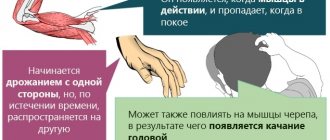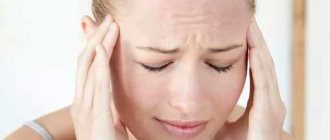When treating this symptom, an integrated approach is used that helps reduce its intensity and remove the cause of the neurotic disorder. Several types of assistance are used for this.
In life, a person faces various situations that strain his nervous system: there is no way to respond to grievances, fear arises due to a lack of a sense of security, it is not possible to implement plans, and so on. All conflict situations and shocks do not remain without a trace in the body. As a result of the action of psychotraumatic factors, a person develops the disease neurosis . It begins almost imperceptibly and manifests itself differently in everyone. Symptoms and external manifestations of the disease depend on the duration of the traumatic situation, its severity and individual reaction to it.
What is neurosis?
Neurosis is a disease in which a person loses the ability to cope with stressful situations . The body’s defenses and the formed psychological adaptation “break down” in this state, leading to exhaustion of the nervous system. This disease affects not only the psyche and the nervous system; a person often notices a malfunction of an internal organ or prolonged pain.
Subscribe to our INSTAGRAM account!
Strong neurosis does not go unnoticed from the outside either. People around note increased irritability and deterioration in the physical condition of a person suffering from this disease.
Causes of tension
- Inadequate perception of the world
Our way of thinking is not in harmony with our external environment. Lack of flexible thinking causes conflict between the desired life and the present reality. This causes dissatisfaction and tension in the mind and body.
- Negative emotions
Fear, hatred, hostility, jealousy and the like. They accumulate from childhood and have a negative impact in everyday life (fear of the dark, inferiority complex, etc.).
If we perceive situations that are unpleasant for us with internal protest and negative emotion, conflict arises in our mind. Our nervous system reacts to this by increasing muscle tension, as if preparing to take action to resolve this conflict. As a result, all internal organs also work more intensely. This leads to a constant waste of our vital energy and an excessive release of adrenaline into the blood. If a person remains in this state for a long time, this can lead to diseases of the internal organs and a weakened immune system.
Therefore, as soon as we notice negative behavioral tendencies, we should think about how to change this state. How to replace tension with relaxation?
Causes of the disease
- An interesting fact is that not only situations associated with the loss of something close can lead to neurosis. The cause of the disease can also be a bright, joyful event , for example, the birth of a child, a wedding, or the start of studies at the desired college or university.
- Neurosis often occurs in melancholic and choleric people. These types of temperament are characterized by emotional instability, so typical melancholic and choleric people have a more difficult time experiencing traumatic situations.
- Physical and psycho-emotional stress ultimately lead to this nervous pathology. If a person constantly works or studies and does not have enough time for relaxation and rest, he is at risk. Especially with accompanying problems in your personal life, the development of neurosis cannot be avoided.
- With long-term or intense somatic illnesses, psychological problems associated with the inability to finish the work started, symptoms of severe neurosis also appear.
DC voltage
How the current flows
In such circuits, the value of the described characteristic remains constant for a long time. A gradual change in the value of this characteristic when connecting consumers (load) to the battery is associated with its discharge - a decrease in the potential difference between the terminals of the power source due to the movement of a larger number of charge carriers from the positive terminal to the negative.
Current and voltage in this case are related by Ohm's law, the formula of which is given below:
I = U/R,
Where:
- I – current strength, A;
- U – potential difference, V;
- R – resistance, Ohm.
Ohm's triangle is a convenient form of the formula of the law of the same name
How does this disease manifest itself?
A neurotic disorder of the nervous system necessarily leads to detrimental consequences for the body and social activity of a person. It can cause neurosis, nausea, dizziness, constant headaches, increased conflict, irritability, and disability. That is why, when neurosis manifests itself, you need to solve the problem, and not hope for its independent disappearance .
The main manifestations of the disease include:
- headaches of various types;
- numbness of the limbs;
- dizziness;
- various types of sleep disorders;
- a person cannot relax if he wants to;
- increased irritability;
- the patient does not feel joy and happiness, he is constantly depressed;
- restlessness, anxiety;
- decrease in cognitive functions, intellectual abilities;
- fast fatiguability;
- pain in internal organs, in the limbs, without obvious reasons;
- decreased labor productivity;
- mood swings;
- tearfulness;
- touchiness;
- “getting stuck” in a stressful situation;
- the body's sensitivity to temperature changes and bright light;
- disorders of the autonomic nervous system: sweating, rapid heartbeat, fluctuations in blood pressure, problems with the stomach;
- decreased sex drive;
- decrease in the intensity of volitional impulses;
- dyspnea;
- dark spots when closing or opening the eyes, the condition is accompanied by dizziness;
- decreased appetite, inability to form a bolus due to insufficient amount of saliva in the mouth;
- the appearance of a feeling of fear without a threatening factor.
Reduced severity of physiological symptoms
The listed signs manifest themselves differently in each patient. For some, neurosis is accompanied by only a few symptoms of the listed manifestations, and some note almost all of the listed changes in their body. Among the common symptoms, patients note headache, nausea, dizziness, tension in the body and head.
Tension in the body
This is the main companion of the disease. Neurotic disorders are almost always accompanied by muscle tension. This phenomenon occurs for both physiological and psychological reasons. In the human body, an uneven distribution of muscle load occurs, and dystonic reactions appear.
Some researchers argue that tension in any part of the body is associated with specific psychological problems. For example:
- Feelings of hostility towards others lead to tense arm muscles.
- Increased muscle tone in the thighs and pelvis in adulthood is caused by sexual problems.
- Tension in the head during neurosis is caused by deep emotions, unresolved conflicts, and low self-esteem of a person.
Psychological problems are very closely related to somatic manifestations. That is why it is necessary to get rid of this symptom as part of a set of measures to overcome a neurotic disorder.
With neurosis, constant tension in the body is treated not only with medications, but also with active use of physical exercises. They are prescribed depending on which muscles cannot relax. The following would be appropriate here:
- relaxation massages;
- various water treatments;
- medications for severe symptoms;
- working with a psychologist, psychotherapist to solve the cause of muscle tightness.
Nausea with neurosis
Not all doctors associate this symptom with psychological problems. Only experienced gastroenterologists or therapists refer the patient for a consultation with a psychotherapist or neurologist when experiencing nausea. Nausea with neurosis can last from several hours to several days. And it should not be associated with low-quality food and take sorbents or bacteria for the intestinal flora - there will be absolutely no result.
Constant nausea in neurosis is often observed with a feeling of disgust towards an object, person or activity, if the patient has accumulated grievances, he is dissatisfied with his life, his health or appearance. Constantly interacting with what a person considers unworthy or bad, neurosis will manifest itself through the main symptom - nausea.
There are two treatment options:
- reducing the severity of symptoms, short-term techniques using antipsychotics or antidepressants;
- long-term psychotherapy aimed at eliminating not only the symptom, but also the causes of neurosis.
Dizziness with this disease
It is enough to associate this phenomenon with the pathology of the nervous system, since dizziness during neurosis is not always accompanied by problems with internal organs. A person may complain of weakness and dizziness, although when tested, all results will be within the normal range; blood pressure measurements will also not show any pathology. In this case, we can safely say that the symptom is caused by psychogenic causes.
Dizziness occurs with depression, panic attacks, vegetative-vascular dystonia, phobias, and anxiety. It is complemented by noise in the head, increased irritability and sleep disorders. With dizziness of a psychogenic nature, it is impossible to cure a person of them without the use of psychotherapeutic techniques.
If dizziness is accompanied by hearing problems and gait disturbances, then we may be talking about disturbances in the functioning of the vestibular apparatus. In this case, an ENT doctor provides assistance. With changes in blood tests and examinations of the cardiovascular system, dizziness is caused by neurological or vascular diseases. A doctor working with a patient cannot immediately diagnose psychogenic dizziness, so first a negative diagnosis should be made - eliminating the physiological causes of the symptom.
In the treatment of dizziness due to neurosis, medications, special gymnastics and breathing exercises, as well as psychotherapeutic techniques are used.
How tension occurs
The process of voltage generation in an electrical circuit consists of the following stages:
- A circuit consisting of conductors and consumers is connected to two poles of a current source (battery or generator);
- One of the source poles (battery terminals or generator contact terminals) contains an excess of electrons, while the other contains a deficiency. The pole on which the charge carriers (electrons) are concentrated is usually called positive, while the second is negative.
- When connected to the power supply circuit, free electrons located on the positive pole and in the conductor, under the influence of the resulting electric field, will begin to be attracted to the negative pole of the battery, which has a positive charge due to the absence of electrons.
- Due to the potential difference between the terminals of the power source in the conductors and the load, an ordered movement of electrons will occur, and a potential difference of a certain magnitude will appear. In this case, the potential of the pole with excess electrons in the case of direct current sources gradually decreases.
On a note. The definition that most clearly and simply explains what voltage is is that it is the difference between the number of free mobile electrons at different ends of the electrical circuit (power source terminals).
Headache due to neurosis, causes
Headache is a faithful companion of neurasthenia and hysteria; it is practically not observed in obsessive-compulsive neurosis. This symptom does not occur immediately after a stressful situation, but after a certain period of time, after the development of other symptoms, for example, sleep or appetite disorders.
Headache with neurosis manifests itself in different ways, depending on the location of pain and the human organs involved. It develops due to:
- Muscle “clamps”.
- Disturbances in the functioning of cerebral vessels.
- Without disruption of muscles and blood vessels.
As a result of this classification, the symptoms of headaches with neurosis will be slightly different.
Neuromuscular pain is accompanied by:
- feeling of squeezing of the head;
- numbness of some parts of the surface of the head;
- sensation of pain on the skin surface of this part of the body;
- a person feels constant tension in the head, which interferes with mental processes: it is difficult to remember something, concentrate attention, or decide.
The neurovascular nature of pain will be expressed through the following symptoms:
- throbbing pain in the head;
- pulsation constantly focuses a person’s attention on pain, he cannot perform any complex mental work;
- often localized in the temporal region, occipital and frontal;
- accompanied by nausea and weakness.
Headache without muscle tension and pulsation in a neurotic disorder occurs after overwork. It does not have a clear localization, and it is difficult to understand the nature of the pain. Its occurrence is associated with psycho-emotional experiences, so it is classified as neurotic symptoms.
How to get rid of neurotic headaches?
It is important for patients with a neurotic disorder to know how to relieve tension and pain in the head during neurosis, because their livelihoods depend on it. When treating this symptom, an integrated approach is used that helps reduce its intensity and remove the cause of the neurotic disorder. To achieve this, several types of patient assistance are used.
Subscribe to our VIBER channel!
Medication assistance
With neuroses, pain in the head can be simply unbearable. A constant feeling of heaviness, constriction and increased severity of pain leads to a deterioration in the patient’s psycho-emotional state. He becomes irritable, gets tired quickly, and does not want to use anything for food, since the chewing process also causes pain. To solve this problem, it is necessary to use medications to get rid of headaches. To do this, the doctor prescribes:
- sedative herbal preparations (Valerian, Peony Tincture, preparations with motherwort, Nervo-Vit);
- painkillers that relieve muscle or vascular spasm (Spazmolgon, Riabal, Novigan, various analgesics and others);
- vitamins to support the functioning of the heart and nervous system (various vitamin complexes with vitamins C, group B, magnesium, iron and other microelements);
- nootropics and anti-anxiety drugs (Glycised, Glycine, Nootropil, Pantogam), they have a good effect on brain function and normalize sleep, but the dosage and course of administration are determined only by a doctor.
Psychotherapeutic assistance
Psychological techniques are used not only to treat headaches, but also to get rid of the causes of neurosis. Cognitive behavioral therapy is actively used, hypnosis is an effective assistant, and it is also important to use positive therapy methods to restore a person’s psycho-emotional sphere. Long-term work with a psychologist or psychotherapist is required.
How to relieve chronic muscle tension
Body and psyche are inextricably linked. The muscular system is subject to emotional influence, which can be expressed, for example, in the deliberate suppression of emotions. The body adapts to stress through muscle tension
Our muscular system is constantly engaged throughout the day. The coordinated work of muscles ensures the normal functioning of the human body, allowing it to perform various physical actions.
During training in the gym, a person’s muscles tense up several times more, and so-called muscle stress occurs. This condition is characterized by short-term muscle pain that completely disappears a few days after training.
However, it's not just exercise that can lead to muscle spasms or chronic tension.
Body and psyche are inextricably linked. Mental processes influence physiology, and the state of the body creates psychological patterns. The muscular system is subject to emotional influence, which can be expressed, for example, in the deliberate suppression of emotions. The body adapts to stress through muscle tension.
This mechanism appears already in early childhood, and in the future it can lead to mental disorders. If you ignore body signals and do not regularly perform psychophysical relaxation, then chronic muscle tension and subsequent disruption of the organic structure of the body is guaranteed . Let's go into a little more detail here.
At the beginning of the 20th century, the Austrian psychologist Wilhelm Reich, in his scientific research, became convinced that the flow of vital energy in the body is blocked out of necessity if a person withdraws from painful and disturbing experiences.
However, with regular suppression of painful experiences, especially in early childhood, such blockages manifest themselves in shallow breathing, constrained mobility, insufficient “aliveness” and lead to a muscular shell.
The muscular shell in various parts of the body is a kind of protection and serves to protect a person from psychological stress and anxious feelings.
Later, one of W. Reich’s followers, Alexander Lowen , came to the conclusion that a person’s attitude to life and his behavior is reflected in his physique, postures, and gestures, and that there is a close relationship between a person’s physical parameters and the make-up of his character and personality as a whole.
Lowen's many years of research led him to the creation of a general bioenergetic model, which suggests that feelings blocked by fear and therefore not receiving outlet are modified or suppressed. All this ultimately leads to disturbances in energy processes in the body, bodily stiffness and unfavorable changes in the psyche.
In everyday life, most people do not pay attention to the fact that the consequences of prolonged anxiety or a nervous breakdown are intermittent shallow breathing, increased heart rate, and nagging pain in the neck and back.
Excessive emotional stress regularly experienced by the body can soon lead to chronic muscle tension.
Chronic tension is a condition of a muscle when it is under constant tension, regardless of whether the person is resting or working. This is due to foci of excitation in the brain. As long as these lesions exist, muscle spasm will be present.
This spasm may not be felt for many years, but eventually the physical wear and tear of the muscle will reach a level where it will no longer be able to perform its functions and will gradually stop responding to impulses sent by the brain.
Many people underestimate, but chronic muscle tension often leads to poor circulation and various kinds of problems and disruptions in the body, for example, deterioration in the functioning of internal organs, constant headaches, dysfunction of the temporomandibular joint, diseases of the gastrointestinal tract and others.
The previously mentioned breathing disorder leads to the development of vegetative-vascular dystonia, problems of the cardiovascular and nervous systems, diseases of the bronchi and lungs, gall bladder and kidneys.
In addition, chronic muscle tension leads to rapid fatigue during the day, constant weakness and apathy. A person loses physical activity, ability to work, memory impairment occurs, and the ability to concentrate is lost.
As noted by students of the Moscow University of Yoga who took a course in meditation, after undergoing a series of sessions of body-oriented therapy in concentration practices, consciousness became more unidirectional, and fewer extraneous thoughts began to emerge.
Other most common causes of muscle spasms include: various injuries, a sedentary lifestyle, lack of physical activity or, conversely, abuse of it. For practitioners of hatha yoga or fitness yoga, it is important to understand that overtraining the body is also harmful, as is lack of training.
To avoid the consequences of chronic stress, people of different age groups are recommended to regularly carry out stress prevention. One of the effective methods is ideomotor training.
Ideomotor (“ideo” from Greek – thought, “motor” from Latin – movement) – mental movement. In other words, ideomotor is the mental replaying of the upcoming activity, working with mental images.
Ideomotor training has proven itself in the process of physical preparation of athletes for upcoming competitions, as well as as an effective means of developing and improving the cognitive functions of the body.
The essence of ideomotor training for relieving chronic muscle tension is that, using a mental representation of tension followed by relaxation, a person can learn to effectively relax even without actual physical exercise, using only work with consciousness.
Let's consider an example of such training , developed by Doctor of Psychological Sciences, Professor Leonova A.B.
This technique is universal for working with various muscle groups. However, to achieve the maximum effect, it is recommended to concentrate on one muscle group where the spasm is most felt and perform several cycles of this exercise.
You need to take a sitting or lying position, take a deep, full breath, then exhale and relax.
Then you should take a deep breath again and hold your breath for a few seconds. At the same time, mentally imagine that you are raising your straight legs up to an angle of 45 degrees. You will feel tension and warmth in your abdominal area. Try to maintain this position for as long as possible. Concentrate on the feeling of warmth.
Next, turn your attention to your hands. Imagine that you clenched your hands tightly into fists. Then they unclenched and released the tension. There is a feeling of a slight pleasant tingling in the hands, it is quickly replaced by a feeling of warmth and heaviness. Warmth and heaviness rise up the arms to the shoulders. Concentrate on these sensations.
Then imagine that you have spread your fingers wide and released the tension. The feeling of spreading heaviness and warmth intensifies. Warmth and light heaviness fill the hands and penetrate deep into the muscles.
To relieve unpleasant tension in the chest, neck and back, you can imagine a warm heating pad lying on your chest. Pleasant warmth emanates from her and permeates the body. Chronic tension in the chest area gradually goes away.
Tension often occurs in the back of the head. It is accompanied by unpleasant sensations and even pain.
In order to relieve such tension, you need to mentally try to reach your ears with your shoulders. A slight heaviness and unpleasant burning sensation may appear, but the tension in the occipital region will disappear within a few minutes. You can perform the exercise from 3 to 10 repetitions.
On average, such a workout can last up to half an hour, and at the end of it you will feel a surge of strength and tone in your body.
Similar methods exist in yoga, where through meditation and other psychopractices you can achieve high-quality relaxation of the body, calm the nervous system and allow the body to recover.
In the “Meditation in a Metropolis” method, as a preparatory stage for concentration, we often use breathing and pulsation techniques through various parts of the body, as well as inducing a sensation of movement in various muscle groups.
This allows, without movements of the physical body that worsen the contemplative state, to quickly get rid of discomfort in the legs, back muscles and other parts of the body that can arise from prolonged sitting.
Thus, summarizing all of the above, we can confidently conclude that ideomotor training is an extremely effective means for relieving and preventing chronic muscle tension in the muscles.
By practicing regularly, you will be able to:
1) learn how to effectively relax your body after a hard day at work and quickly recover during short breaks; 2) get rid of muscle tension while remaining in a meditation position; 3) prevent the occurrence of serious psychosomatic and other diseases dangerous to health; 4) get rid of the feeling of constant fatigue and malaise; 5) achieve a more comfortable and harmonious life for many years.
Author: yoga master, psychotherapist, senior lecturer at Moscow University of Yoga Kirill Rzhanoy











